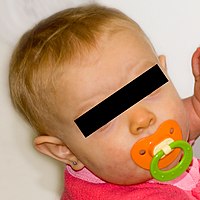
Photo from wikipedia
To the Editor: There is a lack of consensus for wound care in patients with Stevens-Johnson Syndrome (SJS) and toxic epidermal necrolysis (TEN). Conventional dressings, such as gauze with petrolatum,… Click to show full abstract
To the Editor: There is a lack of consensus for wound care in patients with Stevens-Johnson Syndrome (SJS) and toxic epidermal necrolysis (TEN). Conventional dressings, such as gauze with petrolatum, have been the mainstay of treatment for the extensive epidermal wounds. Recent publications have demonstrated a trend towards the use of modern dressings for wound care in SJS/TEN, including silver-impregnated dressings, for the antimicrobial properties and improved patient comfort secondary to decreased frequency of dressing changes.1–5 However, cytotoxic effects of silver have been demonstrated in human cell lines, including fibroblasts, keratinocytes, granulocytes, monocytes, and macrophages. Animal and human studies addressing the possibility of silver toxicity from silvercoated dressings applied to burns have yielded conflicting results with regard to systemic silver absorption.8–13 To our knowledge, this study would be the first retrospective chart review investigating silver absorption in SJS/TEN patients treated with silver nylon and silver foam dressings. After obtaining approval from the University of South Florida Institutional Review Board, we performed a retrospective chart review using the Epic Electronic Medical Record to search for eligible patients. All patients from July 2016 to March 2017 who were diagnosed with SJS/TEN were considered for this study. Patients treated with silverimpregnated dressings met the inclusion criterion, which yielded a total of 14 patients. Those who did not have serum silver measurements drawn during their treatment period were excluded (8 patients). A total of 6 patients were selected for this review, which included 5 adults and 1 child. Serum silver levels had been ordered if the consulted Dermatology team suspected silver toxicity, suggested by argyria, acute leukopenia, and/or elevated transaminases. The results of this retrospective study showed that 5 patients had elevated serum silver levels ranging from 9.9 to 110 μg/L (normal range < 5 μg/L). All 5 patients with elevated serum silver levels had a decrease in white blood cell counts compared with baseline. One patient with normal serum silver levels had a normal white blood cell count throughout admission but developed elevated transaminases. None of the patients developed argyria. Table 1 summarises the patient's characteristics. One patient was treated with silver foam wound dressings (Mepilex Ag, Mölnlycke Health Care US, LLC, Norcross, GA). Four patients received silver nylon wound dressings (Silverlon, BWD, Argentum Medical, Geneva, IL). One patient received both dressings. The silver content of Mepilex Ag and Silverlon is 1.20 and 5.46 mg/cm, respectively. Mepilex Ag is routinely changed every 6 to 7 days, whereas Silverlon is changed every 3 to 4 days. Four patients received IVIG during the hospitalisation, and 1 patient was managed with supportive care only Three patients had underlying haematological malignancies and also had 75% to 100% total body surface area involved, which was characterised by erythroderma and/or erythematous to dusky macules and patches, atypical target lesions, purpura, or areas of skin detachment. Their total body surface area with denuded skin and/or a positive Nikolsky sign was 5% to 25%. Studies regarding the safety of silver-based dressings have yielded controversial results. in vitro studies have indicated that silver released from silver-coated commercial dressings is highly toxic to cultured keratinocytes, fibroblasts, and immune cells. However, the exact mechanism for silver cytotoxicity remains unclear. It has been proposed that ionic silver can cause direct or indirect damage to human DNA. The latter may occur from the increase of reactive oxygen species production or from the decrease of ATP production, both of which damage mitochondria, ultimately reducing energy-dependent DNA repair mechanisms.15–17 In recent animal models of thermal and chemical burns treated with silver nylon dressings, silver ions were detected only in the wound bed but not in blood or other tissues. The authors suggested that silver nylon dressings are a safer alternative than silver nitrate, nanocrystalline silver, or silver sulfadiazine, all of which have been associated with elevated levels of silver ion in blood, urine, and solid organs. In major burn patients treated with a nanocrystalline silver dressing, a prospective study of 6 patients suggested that absorption of silver can occur; however, no systemic adverse effects were Received: 3 January 2018 Accepted: 24 April 2018
Journal Title: International Wound Journal
Year Published: 2018
Link to full text (if available)
Share on Social Media: Sign Up to like & get
recommendations!